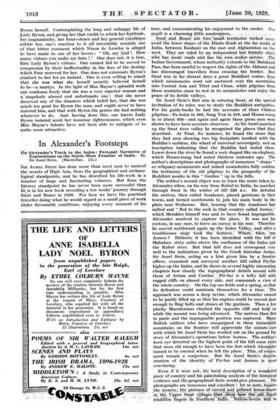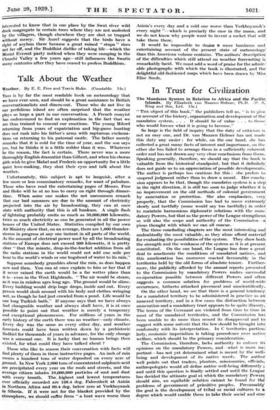In Alexander's Footsteps
On Alexander's Track to the Indus : Personal Narrative of - Explorations on the North-West Frontier of India. By Sir Aurel Stein. (Macmillan. 21s.) Sib Aunni. STEIN has done more than most men to unravel the secrets of High Asia, from the geographical and archaeo- logical standpoints, and he hai described his life-work in a number of large and fascinating volumes. But from the literary standpoint he has never been more successful than he is in his new book recording a ten weeks' journey through SWat and Buner in 1926. For here we have the practised
traveller doing what he would regard as a small piece of work tinder favourable conditions, enjoying every moment of his tour, and communicating his enjoyment to the reader. The result is a_ charming little -masterpiece. _ .
§r4:: and Buner are two T small territories tucked away amid the lower slopes of the Hindu-Kush at the far north. of India, between Kashmir on the east and Afghanistan on the
- west. They are ruled by an independent byt friendly chief, •
who' has 'made' roads and has his Own-sill:dor, service. The Indian GoVernment, whose authority extends to the Malakand Pass, has been careful to respect the rights of the Akhund. and has discouraged travellers from crossing the 'border. But Swat was in far distant days a great Buddhist centre, from which missionaries went out eastward over the mountains into Central Asia and Tibet and China, while pilgrims from those countries came to_rest in its monasteries and enjoy the
peace of its fertile valleys. .
Sir Aurel Stein's first aim in 'entering Swat, at the special invitation of its ruler, was to study the Buddhist antiquities. For his guide-books he had the accounts of .three Chinese pilgrims--Fa-hsien in 403, Sung Yun in 519, and Hsuan-tiang in or about 630—and again and again these pious men were Shown to have been accurate observers. AsSir Aurel marched up the Swat river valley he recognized the places that they described. At Tirat, for instance, 'he found the stone that they had seen showing two big footprints marked with 'the Buddha's emblem, the wheel of universal sovereignty, and an inscription indicating that the Buddha had rested there. LOWer down the river he found a rock shaped like an elephant, which Hsuan-tsang had noted thirteen centuries ago. .The authOr's descriptions and photographs of numerous " stupas " or reliquary-monuments and ruined monasteries fully confirm the testimony of the old 'pilgrims to the prosperity of lhe Buddhist monks in this " Garden " up in the hills.
The author's second object was to trace the route taken by Alexander when, on his way from Kabul to India, he marched through Swat in the winter of 327-326 B.C. He defeated the natives, then called Assakenoi, placed garrisons in their towns, and turned southwards to join his main body in the plain near Peshawar. But, hearing that the Assakenoi had rallied and " fled to the rock in that country called AomOs," which Herakles himself was said to have found impregnahle, Alexander resolved to capture the place. It was not his custom, in any case, to leave an enemy in his rear. Therefore he moved northward again up the Indus Valley, and after a troubleinme siege took the - Where,' then, " Ives Aornos ? Hitherto it has been identified with the hill bf 'Mahaban, sixty miles above the confluence of the Indus-and the Kabul river. But that hill does not correspond 'very well to the indications given by the Greek historian Arrian. Sir Aurel Stein, acting on a hint given him by a frontier officer, examined. and .surveyed another hill called Pir-Sar higher up the Indus,. and he shows several highly interesting chapters how closely the topographical details accord with those of Arrian and Curtius-.." Pir-Sari is a lofty hill with rugged cliffs on almost every side, and commands a view _of the whole country. On the top are fields and a spring, so-that its defenders could maintain themselves for a time. The approach was across a deep ravine, which Alexander caused to be-Partly filled up so that his cngines could be moved near enough to fling bolts and stones at the garrison. Then a few plucky Macedonians climbed the- opposite cliff and held on while the mound was being advanced. The natives then -fled in panic and the impregnable position was captured. Many British soldiers who have campaigned in these intractable mountains . on the frontier will appreciate the minute are with which Sii Aurel Stein has worked out on the ground the story 'of Alexander's operations before Aornos. The author's keen eye detected on the highest point of the hill some ruins that seem old enough to have been the fort which Alextuider
. -
caused to be erected when he left the place,. This, of course,
must remain a conjecture. But Sir Aurel Stein's demon- stration of the identity of 'Pir-Sar and Aomos is most convincing.
Even if it were not, his lucid description of a wonderful piece of country_ and his psiinstaking analysis of the histOricil evidence and the geographical facts would give pleasure. His .photographs are numerous and excellent : let us note, besides Ahe SOOT: v, the. pictures of cntyzed:alyil.pgaired house fronts in tht-tr er. Swat villa es triedifion eis ie.tovill -be Isrortfiern India. aii * interested to know that in one place by the Swat river wild duck congregate in certain• trees where they are not molested by the villagers, though elsewhere they are shot or trapped without mercy.' Sir Aurel suggests that the birds have a right of asylum there because a great ruined " stupa " rises not far off, and the Buddhist dislike of taking life—which the ?Joint Everest party noticed when they were camping in the Chumbi Valley a few years ago—still influences the Swatis many centuries after they have ceased to profess Buddhism.









































 Previous page
Previous page